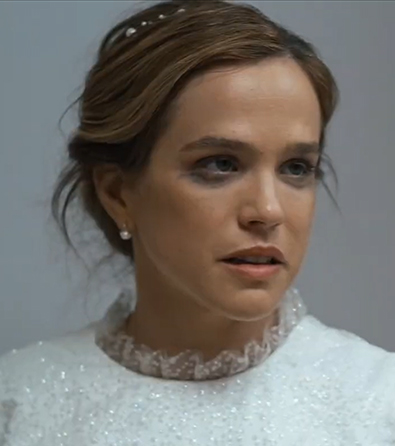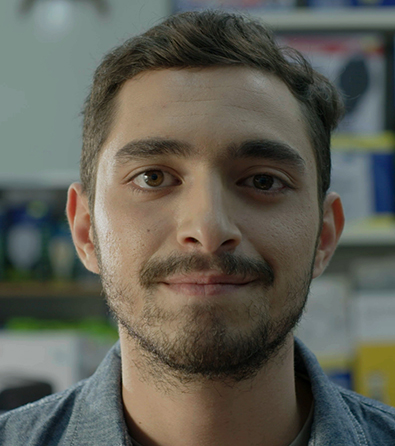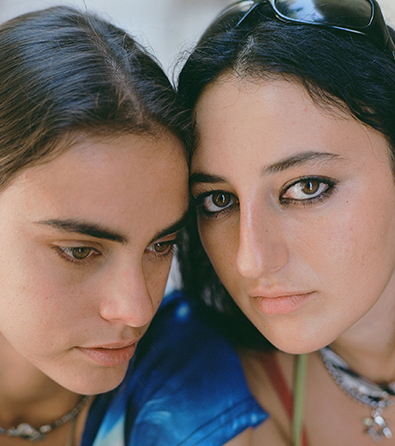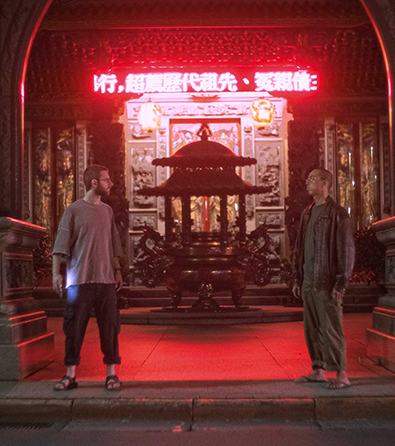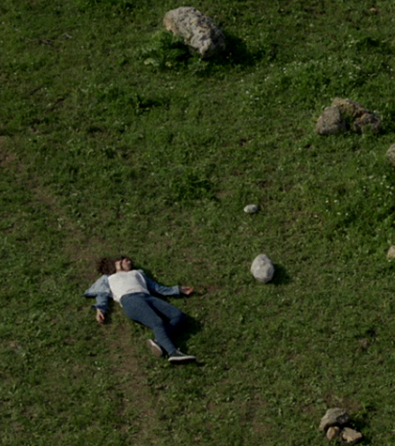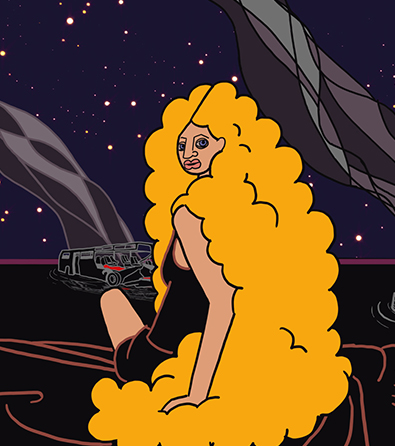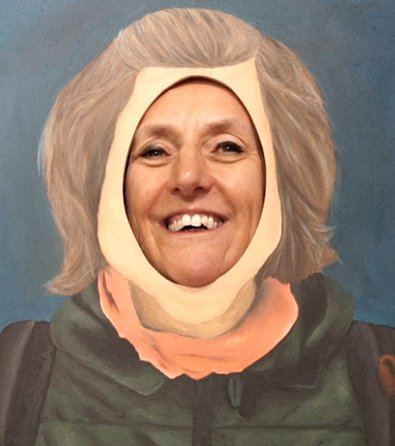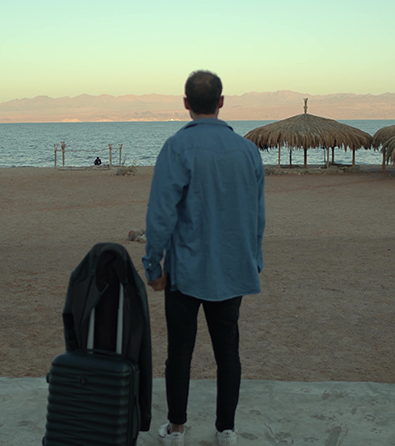The short film Mira (26 minutes) is available at the top of the page.
* To watch this film, please approve YouTube/Vimeo cookies via the blue cookie icon at the bottom left of the screen.
When writing about the short film Mira (2023), directed by filmmaker, actress, and producer Alma Ben Zeev and dedicated to her grandmother Mira, there is an urge to initially refrain from revealing their rather well-known family heritage. After all, the film, which received the award for Best Student Film at the EPOS International Art Film Festival, centers first and foremost on the intimate personal bond between a granddaughter and her grandmother in the final years of her life.
The film casts light on the life of a Jewish immigrant who, as a child, fled with her family from the Kraków Ghetto to Brazil at the outbreak of the Second World War, and then immigrated at twenty to Israel to join a kibbutz. It portrays a woman who sought joy in music even within the austerity of kibbutz life, and who resisted the institution’s authority when it sought to dictate her way of living; a woman who later moved to Tel Aviv, entering the bohemian circles of the big city, where she first felt fear rather than belonging; a woman who became a mother wholly devoted to raising her twin daughters, and who speaks candidly about the difficulties of motherhood as much as about its love and devotion; a woman who effortlessly threads poetry into everyday conversation and delights in the beauty of a fair Tel Aviv day, even as her later years are shadowed by recurring nightmares.
Yet Mira, whose surname is deliberately absent from the film’s title, is more widely remembered as Mira Perlov: the wife of the legendary filmmaker, artist, and teacher David Perlov, and the mother of choreologist and dance artistic director Naomi Perlov and of film editor and producer Yael Perlov (director Alma Ben Zeev is Yael’s daughter, and the film’s cinematography was carried out by Yael’s son Hillel Ben Zeev Perlov, Alma’s brother). Mira’s presence is immortalized in David Perlov’s monumental work Diary (1983), chronicling his life and family. Excerpts from the Diary in which Mira appears are woven into Alma Ben Zeev’s short film, along with footage from other works: David Perlov: Portrait (2014) by Ruth Walk and A Day in the Personal Diary (1984) by Asher Tlalim. In all three, David Perlov takes central stage, while Mira is kept at the margins. As she remarks in Tlalim’s film, when asked whether the Diary she helped produce might also be hers: “I am one of the objects because I am here, but it is certainly not my diary. It is David’s.”
Ben Zeev uses her film to confront this complex position faced by her grandmother and express her wonder about “that gap between being the educated, brilliant woman, the source of inspiration, and her choice to live in my grandfather’s shadow, without frustration.” Ben Zeev constructs a portrait marked by contradictions: Mira who accepted her role as the one who stayed at home with the children, against Mira who did not want to be “a tail” to her husband; Mira photographed tucked away in a car, glancing at her husband as he stands outside with a camera, against Mira insisting on adding her handwritten name, “Mira,” beside the printed name “Perlov” on a page; Mira who succumbs to the exposure that comes with life beside an artist, against Mira captured in the first episode of Diary while on holiday in Eilat, where her generous smile suddenly fades, leaving only a detached and undecipherable gaze. Perhaps Ben Zeev’s film expresses, at least in part, a wish to give Mira the spotlight for once, to undermine her position as “one of the objects.” Or perhaps it is an attempt to hold on to as much of her as possible, in what is revealed as the final chapter of her life.
The impending farewell is already present in the film’s opening scene. The chirping of birds gradually fades in, preceding an appearance of a still photograph of Mira and Ben Zeev side by side, laughing. Over this image, Ben Zeev tells of a Portuguese poem that Mira once shared with her:
“Death comes like the sound of a bird flapping its wings, appears, and in a moment disappears.”
This simile, evoking the untamed and haphazard impatience of nature, carries an effective sensory impact. Death is rendered as sound: the flutter of wings that the ear is built to catch, but by the time the eye begins its pursuit of the source, it is already too late. The simile underscores the tension at the very heart of cinema, an art that resists the limits of sight. Like the flutter of wings, the sound of narration in this opening scene emerges and vanishes in an instant, while the still photograph of grandmother and granddaughter persists, stretching into permanence a moment of laughter whose sound is long gone. Thus, the scene expresses cinema’s attempt to preserve reality (while always sacrificing part of the reality in the very act of preservation), as well as cinema’s dependence on movement and time, on the fleeting.
The next shot in the film shows the entrance to the residential building on Shaul HaMelech Street in Tel Aviv, where the Perlov family lived. Perhaps not by chance, a pigeon is seen pacing near the doorway. Much of Mira unfolds within this building: in the apartment’s rooms with their black floor tiles, abundance of pictures on the walls and sweeping fourteenth-floor views; in the lobby and the elevator; and in the surrounding neighborhood, at street corners and nearby cafés. In this way, Mira extends the path of Perlov’s Diary, much of which was likewise filmed in the apartment and its surroundings. The familiarity of the apartment from Diary lends its later depiction in Mira a note of longing and contributes to the apartment’s almost mythic aura, a place where many of the city’s artists and Perlov’s film students once gathered and worked.
Against the backdrop of the building’s façade, Ben Zeev declares in voiceover: “I am starting from the beginning.” The words echo an almost identical statement made by Perlov in the opening episode of his Diary, which leads him to cut to footage he filmed in Brazil, his birthplace. For him, the beginning was the land where he was born and raised. Ben Zeev, too, cuts after her declaration to excerpts from her grandfather’s Diary. For her, the beginning lies in the images of Brazil and in the act of watching Diary itself. The beginning is a cinematic image. She admits her surprise at discovering how little Mira appears in Diary, and how she holds on to those few fragments of her presence. In that moment, she states her purpose plainly: to create a film about Mira before it is too late. Time presses her to move quickly, against the ticking clock.
The issue of time is brought up in the film in many ways, most powerfully through editing choices. Alongside excerpts from existing films, Ben Zeev weaves in home videos, photographs, and drawings of Mira made both by Perlov and by the Lithuanian-Brazilian artist Lasar Segall, for whom she also served as a subject. She layers these with recordings of her own phone conversations with her grandmother, integrated into the soundtrack. Similarly to the tension between image and sound in the opening scene, these everyday phone calls are not visually shown on screen, but rather paired with visual traces from other times: old photographs of Mira, shots of the apartment’s rooms and objects, or images of Mira and Alma walking together in the neighborhood. Through this editing, the viewer becomes aware that the phone call takes place in a different time than the one portrayed on screen. In doing so, the film breaks the unity of sound and image and, with it, the illusion of cinematic reality.
The effect is most powerful in moments when Mira’s voice is heard in a phone call with Ben Zeev over images of the apartment’s empty rooms, and most poignantly in the shot of a bed with its sheets left rumpled, as if abandoned only a moment earlier, like the flutter of a bird’s wings. In these instances, the editing creates an impossible time in which the voice of an absent body reverberates, audible yet unseen. This artistic choice accentuates the passing of time, a theme further expressed in the film’s closing scene, where Mira recites the words of the classic jazz standard As Time Goes By, as the piano melody plays in the background. This focus on time passing is reminiscent of central themes in Updated Diary (2001), David Perlov’s sequel to Diary. Updated Diary opens and closes on a shot of Venetian Renaissance painter Giorgione’s The Old Woman, a painting showing a woman holding a scroll inscribed with the words Col Tempo (“With Time”). Perlov died four years after the film’s release. Mira passed away about a year after Ben Zeev’s film was completed. They are buried side by side at Kibbutz Einat.
Mira’s recitation of As Time Goes By occurs during a get-together with Ben Zeev that takes up most of the film’s final third. Seated beside her granddaughter in the living room, she appears different from her previous depictions in the film, which had been recorded in earlier times. Her body is sat heavily in her chair, her gaze turned downward. As Ben Zeev notes in the narration, at this point, their meetings were fewer and fewer, and eventually even their phone conversations became scarce. She suggests they go out for coffee. They slowly make their way down the stairs and outside, with Ben Zeev shielding her grandmother’s face from the sun. In the background is a recording of Mira saying how much she loves to walk and how proud she is of her legs. “Nur Geyen un geyen, always walking and walking,” she says, quoting a line from the first episode of Diary. In Diary, this line, in itself a quote, is described by David Perlov as the Yiddish words spoken to him by his landlady when he first arrived in Israel. The quote can thus be read in the context of Mira’s repeated experience as a migrant, whose move to the kibbutz replaced the birdsong of Brazil with Israel’s unsettling black starlings, (another echo of the bird motif that runs through the film). It can also be understood as a reflection of her enduring life force, moving her forward despite her hardships and the slowing of her body.
At the café, with a contemporary Latin rhythm playing in the background, the pulse of life fills Mira as she moves her shoulders to the beat. Perhaps the song reminds her of the rhythms of Brazil. She and Ben Zeev burst into a cheerful “ta ta ta ta ta,” a playful exchange that only the two of them share. The scene then cuts to the confined space of the building’s elevator, where Mira in her sunglasses seems to withdraw into herself once more, and the two return home.
The elaborate depiction of Mira and Ben Zeev’s day together is carried out with patience. Ben Zeev allows the sequence much screen time, even as it contains no major revelations about Mira, her achievements, her past. Instead, it dwells on something else: small and seemingly ordinary yet heart-wrenching moments that offer a glimpse into the subtleties of Mira’s charm and of her relationship with her granddaughter. At this point, it seems that Ben Zeev’s urgency to preserve Mira in her entirety before it is too late subsides. Mira and Alma sit together at the table while Mira’s recorded voice is heard in the background: “What are we waiting for?” “Nothing,” Alma replies. There is no longer a need to hurry, to capture and hold on to every part of Mira. There is no more need for “Nur Geyen un geyen”. Simply being together is enough, as time goes by.

